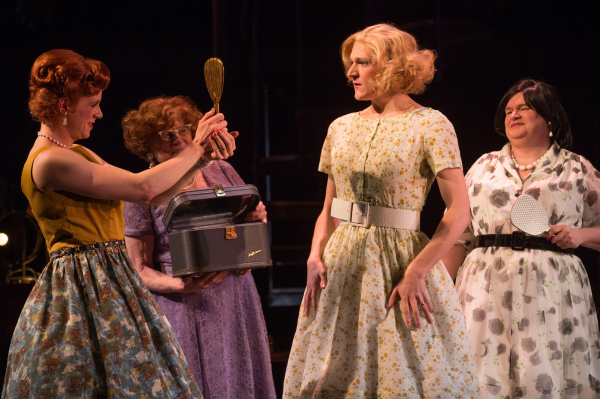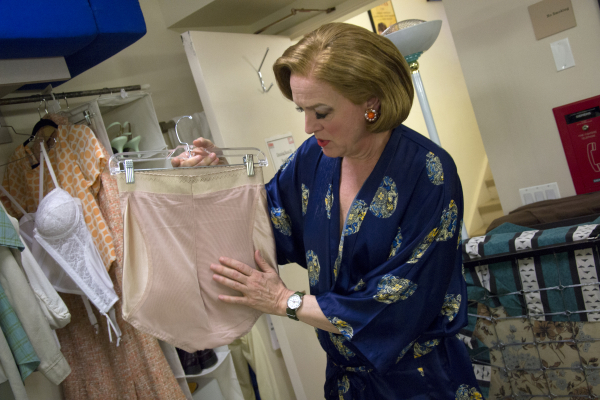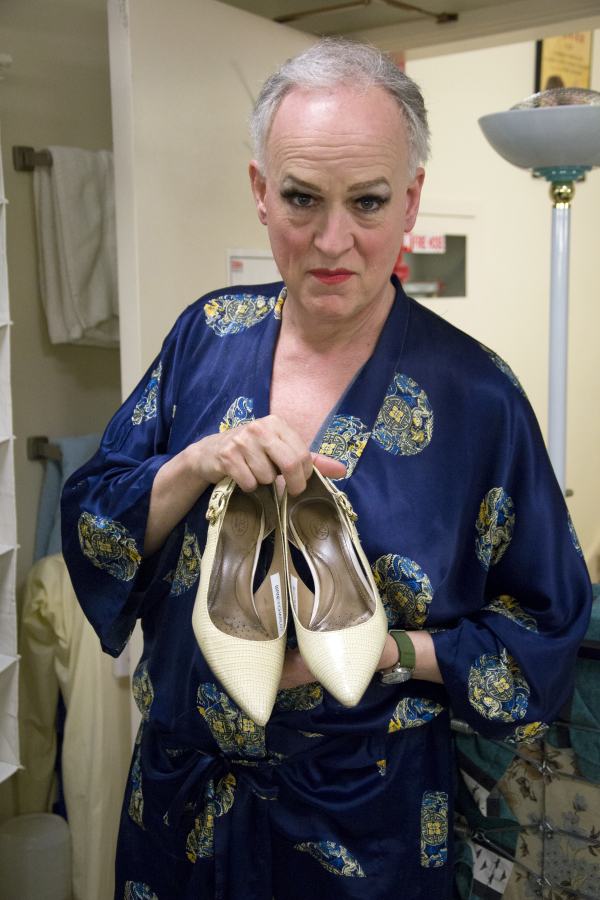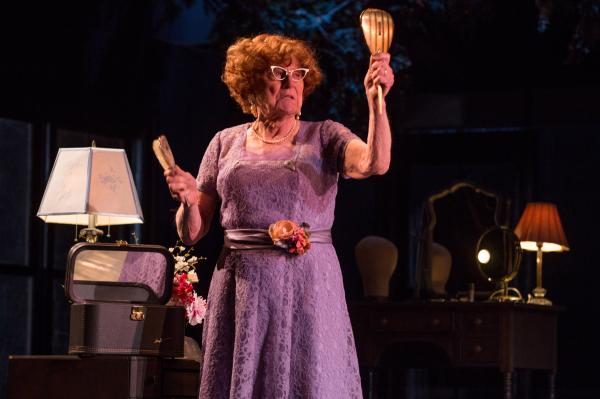How to Dress a Company of Men in Feminine '50s Frocks: Designer Rita Ryack on Creating the Ladies of Casa Valentina

(© Matthew Murphy)
Even for a prolific feature-film costume designer, producing costumes on Broadway can be daunting. In theater, a character's clothes must read correctly to patrons seated everywhere from the first row to the back of the balcony. Costumes must be sturdy enough to withstand the wear and tear of an eight-show week while still allowing for 30-seconds-or-less backstage "quick changes." And in the case of Casa Valentina, Harvey Fierstein's new Tony-nominated play, the clothes serve as the foundation for the plot itself.
"Of course I was nervous," designer Rita Ryack told TheaterMania, referring to the prospect of designing the clothes that would turn Casa's seven-man cast into a group of domestic goddesses. But Ryack tackled the challenge head-on, and shared insights about her process, from choosing fabric to creating busts where there were no busts before.
The Preparation

(© David Gordon)
Ever the consummate professional, Rita Ryack comes to her projects prepared — in terms of everything from pre-rehearsal research to mysterious industry connections. To begin the process, Ryack got her hands on the primary source: Casa Susanna, a book filled with amateur photographs of cross-dressing men at the Casa Susanna lodge in upstate New York. The book, and the real lives of the people it depicts, was the inspiration for Casa Valentina.
Ryack remembers her first impressions of looking at the images. "It's the girls just posing for shots in their clothes. They're quite casual for the most part. They just wanted to look like ordinary women."
She took that idea and ran with it, imagining whole wardrobes for Casa Valentina's "girls" and researching where that clothing might have come from. "There was a person, Katherine Cummings, who is a friend of Harvey's, and she wrote a book about her experiences as a cross-dresser," said Ryack, "She was from Australia, and she found seamstresses who would make her clothes. And you could get clothes for bigger ladies. I did see an awful lot of real clothes in those pictures. And some of our guys did fit into real vintage clothes, like Nick [Westrate] and Gabe [Ebert]."
The veteran designer also drew on her extensive feature-film experience. In 2007, she dressed John Travolta as Edna Turnblad in the Hairspray movie and, in the process, learned a lot about women's foundation undergarments for men and sourcing hard-to-find fabric. Both knowledge bases ended up being invaluable, especially because it was important to Ryack to use real, rare vintage fabric for Casa's costumes. "I have my sources," she disclosed, "I can't reveal. There's a finite amount left."
The Details

(© David Gordon)
As Ryack began the work of creating the actual costumes that the actors would wear for the majority of the show, she was mindful of each character's specific situation. "We considered their personalities, their age, and their socioeconomic bracket," she explained. "We didn't want to make them look like drag queens or clowns." Instead, she wanted them to be dressed for dinner. "They're a little dressed up because Charlotte is coming to visit — it's a special occasion."
The physical bodies of the actors and their characters were another big factor in conceiving and creating their costumes. In many cases, factors like the dimensions of hips and waists determined whether vintage dresses would be sourced or new ones created.
"Gabe's transformation dress is a real one. It doesn't fit very well." But, Ryack continued, "that's part of it." The clothes were cut for butts and busts that guys just don't have.
And sometimes the fit is intentional. "Reed Birney's character…she's coming from work, so that's what that suit is all about. It's businesslike, a little big in the hips. Some people thought that costume looks too big. But it's not…it's really intentional."
The Shoes Make the (Wo)man

(© David Gordon)
As any fashion guide will tell you, an outfit begins with the right shoes. And according to Ryack, the costumes in Casa Valentina were no exception. In fact, she says they were her (and the actors') greatest challenge.
"We had femininity classes before rehearsals began, so that's when we fit all the corsets and girdles and shoes. And we kept having to go back and buy more shoes and more shoes. Those poor men. They rehearsed in them from the beginning."
Actually acquiring all those shoes was easier said than done, because the men, obviously, have feet bigger than the average pair of pumps will fit. "There are cross-dresser resources, and some stores have extended sizes," Ryack said. "We tried everything. The rule usually is that when men wear women's shoes, you go up two sizes from the women's size. But in this case, two sizes were too big on all of the men, so we had to trade them for smaller shoes, but they have very wide feet so that went on and on."
In the end, the ever-patient designer was able to source shoes from a number of places — some quite unexpected. "We did get shoes from Payless. They sell big-size shoes. It's very interesting to see the different markets that all these places serve."
The Final Product
Many of Ryack's most brilliant costuming ideas came because of her personal interest in the project. "I love the early sixties," she said. "It's my favorite period. There's something about the fabrics and the silhouette. It's very simple and the silhouettes are very repetitive." So all of the excitement, according to Ryack, is in those secretively sourced fabrics.
"It really was fantastic and a huge privilege to dress John Cullum in his lavender lace. It's sort of mother-of-the-bride and classic. I was very excited to make that. That actually was based a little bit on Big Mama in [the film] Cat on a Hot Tin Roof — Judith Anderson. If she can wear a corsage, John can wear a corsage. And he could! And it doesn't look ridiculous. They look so natural in those clothes. It's very exciting." What she's most proud of, Ryack said, is "pulling it off."

(© Matthew Murphy)










